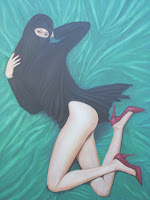On my post yesterday, I touched on veil fetish art. While researching, I came upon artist Makan “Max” Emadi, whose series “Islamic Erotica” touches upon some very similar points. His paintings highlight the alternate concealment and exposure of Muslim women’s bodies and put them in different arrangements.
 In an interview with myartspace>blog, interviewer Brian Sherwin looks at Emadi’s paintings and sums them up perfectly: “he [Emadi] portrays Muslim women in a style that references American pin-up art and modern advertising. The contradictory nature of this series creates an outlandish vision of how the Middle East is being changed by the ever-expanding arm of globalization and the growing influence of American-style democracy.”
In an interview with myartspace>blog, interviewer Brian Sherwin looks at Emadi’s paintings and sums them up perfectly: “he [Emadi] portrays Muslim women in a style that references American pin-up art and modern advertising. The contradictory nature of this series creates an outlandish vision of how the Middle East is being changed by the ever-expanding arm of globalization and the growing influence of American-style democracy.”
Emadi’s own words about this series pit it as an Eastern sexism vs. Western sexism brawl: “Representation of the female body is forbidden in strict Islamic tradition, and is therefore taboo in today’s Muslim cultures. To imagine Western art without the nude is, in contrast, impossible. These paintings revisit the Western tradition of pin-up art and its ‘celebration’ of the female form while ‘lovingly’ objectifying it through overexposure and unnatural posing of the model. The Middle East’s version of sexism, in contrast, takes the form of control through mandated repressive female clothing, or ‘Hejab,’ in the name of protecting and honoring women.
I have avoided referring to my heritage in my work until now. After all, I have lived in Los Angeles most of my life, not Iran, and expressing ‘pride in cultural diversity’ has been too fashionable a movement for me. However, in recent years, as in 1979, when my family immigrated to the United States, I have been confronted by my ‘otherness’ on a more regular basis. As the battles between fundamentalists on both sides of the globe rage on, so do my bicultural conflicts.
In my new series of paintings, ‘Islamic Erotica,’ I have portrayed Muslim women in a style that references American pin-up art, modern advertising, and photographs of tribal women in National Geographic-type publications.
When these seemingly contradictory traditions are combined, we can envision an absurd future where the ever-expanding arm of globalization and the growing influence of American-style democracy in the Middle East will continue to manifest into stranger and more outlandish hybrids.”
I take a few issues with his statements. First, if we’re going to talk about strict Islamic tradition, representation of any living form is forbidden: that includes women, children, men, and animals. And, while the female nude is an important form in Western art, so is the male nude. Did Emadi completely forget ancient Greek and Roman sculpture? Also, I don’t see how these paintings refer to his cultural heritage. He is Iranian, and the majority of Iranian women “traditionally” wear the chador, not the niqab and abaya.
That said, what do you think about these paintings? Is his point of globalization vs. tradition conveyed? Could he have conveyed it with both male and female models?
